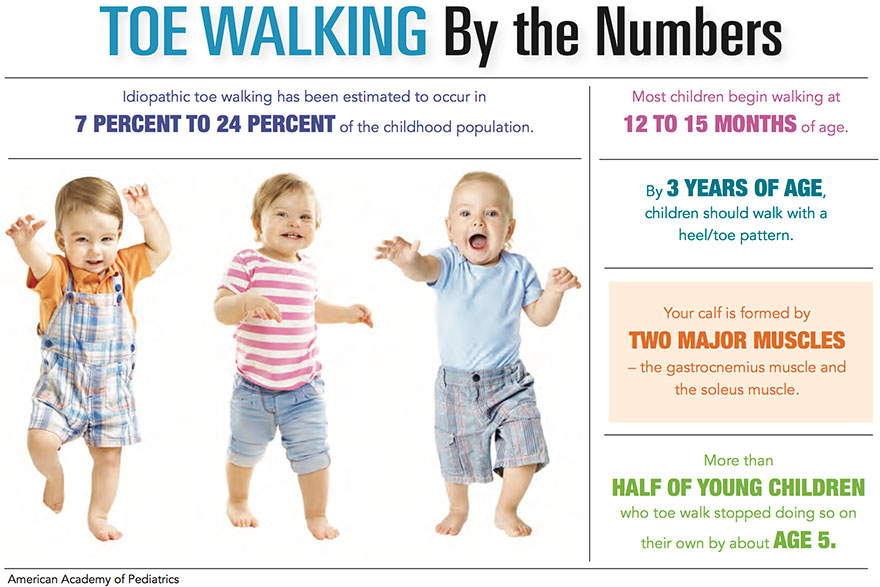As a child, I tiptoed. Not just through the house on Christmas morning but always. It was my trademark, my “funny characteristic” that made people notice me. It got to the point that my mother and grandmother decided it was time to find out why, exactly, I was walking on my toes. They refused to believe me when I said that it was a “sign” I should take ballet classes. Nope – instead, they sent me to tap dancing classes and a podiatrist. But as it turned out, there was nothing wrong with me.
“It’s just a habit!” the doctor finally told my family.
The truth is that many young children walk on their toes. Sometimes it’s for a medical reason, but sometimes, as it was with me, it’s for no reason at all. The stages of walking that begin in babyhood start with the toes, and, sometimes, a child may be a late bloomer and continue the pattern for a longer period. While parents might feel anxious at the sight of their little one “tiptoeing through the tulips,” as the old song says, it is best not to get too worried at first; a little patience goes a long way.
“All kids go through different stages of walking, and they don’t start walking heel to toe since those muscles are not yet developed,” said Dr. Rahn Ravenell of Coastal Podiatry. “Children that age also don’t have the balance. So they take quicker steps with shorter strides.”
“Toe walking should never be a cause for automatic alarm,” said Dr. Ashley Jenkins of Hometown Pediatrics. “It’s all about time frames. For a child who is beginning to walk, it can be a perfectly normal quirk they will outgrow. For a child under 2, it’s appropriate to provide reassurance and watchful waiting.”
And what if the tiptoe habit continues well after toddlerhood? Even then, it’s likely to be idiopathic – in other words, for no reason other than habit. Physicians who are accustomed to seeing parents who are concerned about a toddler or young child who tiptoes know to ask a variety of questions that will narrow down the cause for the toe walking and determine whether further investigation or therapy will be needed.
“I see kids and parents who come in with this concern, and I ask questions about family history,” Dr. Ravenell said. “A lot of times, these kids pick up the habit from other family members, including siblings.”
“In our particular clinic, Hometown Pediatrics, we typically hear about concerns for gait disturbances around the 12- to 15-month checkup,” Dr. Jenkins said. “The majority of counseling centers advise watchful waiting. But any child toe walking past the age of 2 should undergo a thorough history and physical exam. If the exam and history are normal, it might just be a habit or family trait.”
A short or tight achilles tendon – the main tendon on the back of the leg and ankle – can cause a child to tiptoe, and physical therapy can typically remedy the situation of either habitual or tendon-related toe walking.
“Sometimes a child will have a very short or tight achilles tendon that won’t actually allow them to stretch their heel to the ground, meaning they must toe walk,” explained Dr. Jenkins.
“A tight or short achilles tendon can mean toe walking or a bounce,” said Dr. Ravenell. “The achilles is the tendon that helps us press the gas pedal, go up a flight of stairs or get up on our toes. If it’s tight, the natural inclination is to come off the ground. And it’s hard to strike with the heel.”
In some cases, however, toe walking can indicate something more serious, be it physical or neurological.
“If a child has neurological findings on an exam, this may point toward underlying cerebral palsy, muscular dystrophy or peripheral neuropathy,” said Dr. Jenkins. “In those cases, a referral to a specialist would be recommended. Autistic children may also toe walk, and so a developmental assessment is also important.”
“Toe walking that is not a habit or caused by a tight achilles tendon could be the result of a muscular disorder, which we would want to rule out,” said Dr. Ravenell. “Spinal cord abnormalities and cerebral palsy are examples.”
No matter the cause of the toe walking, addressing it at the right time in a child’s development is important; ignoring gait problems can lead to other difficulties later in life, mostly due to muscle tightness. Thus, even habitual toe walking or tight tendons can and should be addressed with physical therapy.
“Long-term toe walking can lead to muscular tightness around the calf and the ankle,” noted Dr. Jenkins. “Learning exercises can help with this, so patients are often referred to physical therapy programs that set them up with a routine to do at home. More invasive measures include bracing, casting, surgery to elongate a short heel cord or even Botox injections.”
“Issues that might develop with long-term toe walking include atrophy of the muscles that are not being used, foot pain and tendonitis due to other tendons compensating,” said Dr. Ravenell. “Habitual toe walking can be fixed with physical therapy.”
By Denise K. James





